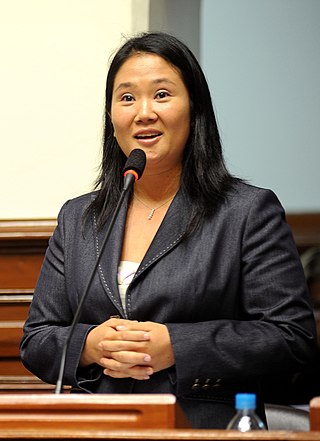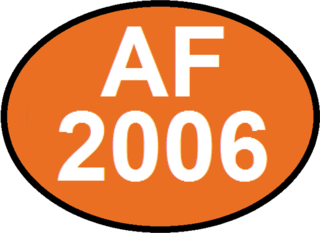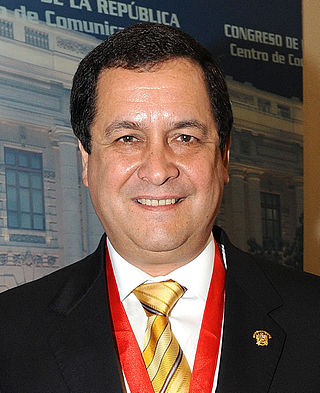
The politics of the Republic of Peru takes place in a framework of a unitary semi-presidential representative democratic republic, whereby the President of Peru is both head of state and head of government, and of a pluriform multi-party system. Executive power is exercised by the President and the Government. Legislative power is vested in both the Government and the Congress. The Judiciary is independent of the executive and the legislature. The Economist Intelligence Unit rated Peru a "hybrid regime" in 2022. Traditionally weak political parties saw their support collapse further in Peru since 2000, paving the way for the rise of personalist leaderships. The political parties in the congress of Peru are, according to political scientist Lucía Dammert, "agglomerations of individual and group interests more than solid and representative parties".

The Peruvian Armed Forces are the military services of Peru, comprising independent Army, Navy and Air Force components. Their primary mission is to safeguard the country's independence, sovereignty and territorial integrity against any threat. As a secondary mission they participate in economic and social development as well as in civil defense tasks.

Alberto Kenya Fujimori Inomoto is a Peruvian former politician, professor and engineer who served as President of Peru from 28 July 1990 until 22 November 2000, though de facto leadership was reportedly held by Vladimiro Montesinos, the then head of the National Intelligence Service. Frequently described as a dictator, he remains a controversial figure in Peruvian politics. He was sentenced to 25 years in prison for human rights abuses during his presidency but was released on 6 December 2023 following an order by the Constitutional Court of Peru.

Vladimiro Lenin Ilich Montesinos Torres is a Peruvian former intelligence officer who was the long-standing head of Peru's National Intelligence Service (SIN) and was reportedly the de facto leader of Peru while President Alberto Fujimori served as a figurehead leader. Montesinos had strong connections with the U.S. Central Intelligence Agency (CIA) for over 25 years and was said to have received $10 million from the agency for his government's anti-terrorist activities, with international bank accounts possessed by Montesinos reportedly holding at least $270 million. The United States reportedly supported the candidacy of Fujimori during 1990 Peruvian general election due to his links to Montesinos and ignored human rights abuses performed under Montesinos during the 1990s. In 2000, the infamous "Vladi-videos" came to light when they were broadcast on the news. They were secret videos recorded by Montesinos that showed him bribing elected congressmen into leaving the opposition and joining the pro-Fujimori group of the Congress. The ensuing scandal caused Montesinos to flee the country and prompted Fujimori's resignation.

El Comercio is a conservative Peruvian newspaper based in Lima. Founded in 1839, it is the oldest newspaper in Peru and one of the oldest Spanish-language papers in the world. It has a daily circulation of more than 120,000. It is one of the most influential media in Peru.

Francisco Remigio Morales Bermúdez Cerruti was a Peruvian politician and general who was the de facto President of Peru between 1975 and 1980, after deposing his predecessor, General Juan Velasco. His grandfather and all his original family were from the old Peruvian department of Tarapacá, which is now part of Chile. Unable to control the political and economic troubles that the nation faced, he was forced to return power to civilian rule, marking the end of the Revolutionary Government of the Armed Forces installed by a coup d'état in 1968.

A self-coup, sometimes known as the Fujimorazo, was performed in Peru in 1992 after President Alberto Fujimori dissolved the Congress as well as the judiciary and assumed full legislative and judicial powers. With the collaboration of the military, the Fujimori government subsequently began to implement objectives of the Green Plan following the coup.

Keiko Sofía Fujimori Higuchi is a Peruvian politician. Fujimori is the eldest daughter of former Peruvian president Alberto Fujimori and Susana Higuchi. From August 1994 to November 2000, she held the role of First Lady of Peru, during her father's administrations. She has served as the leader of the Fujimorist political party Popular Force since 2010, and was a congresswoman representing the Lima Metropolitan Area, from 2006 to 2011. Fujimori ran for president in the 2011, 2016, and 2021 elections, but was defeated each time in the second round of voting.

Ollanta Moisés Humala Tasso is a Peruvian politician and former military officer who served as President of Peru from 2011 to 2016. Originally a socialist and left-wing nationalist, he is considered to have shifted towards neoliberalism and the political centre during his presidency.
The mass media in Peru includes a variety of different types of media, including television, radio, cinema, newspapers, magazines, and Internet-based web sites. Much of the print-based media in Peru is over a century old, with some newspapers even dating back to the time of independence.

Peru and the United States established relations on May 2, 1826, following Peru's independence from Spain.

Fujimorism denotes the policies and the political ideology of former President of Peru Alberto Fujimori as well as the personality cult built around him, his policies and his family, especially Keiko Fujimori. The ideology is defined by authoritarianism, its support for neoliberal economics, opposition to communism, and socially and culturally conservative stances such as opposition to LGBT rights and school curriculums including gender equality or sex education. Opponents of Fujimorism are known as anti-Fujimorists.

The National Population Program, known as the National Program for Reproductive Health and Family Planning from 1996 to 1998, was a project conducted in Peru in through the 1990s to reduce population growth as a way of meeting international demographic standards. Plans for the "total extermination" of impoverished Peruvians through sterilization were included in Plan Verde, a covert military operation created to establish a neoliberal military junta. Compulsory sterilization, which is a method that forces individuals to partake in sterilization operations, was the main method employed by the Peruvian government to decrease population.
Forced sterilization in Peru was part of a larger effort variably described as the ethnic cleansing or genocide of indigenous peoples of Peru that occurred under the government of Alberto Fujimori through his National Population Program, with the such projects first being outlined in the Plan Verde of the Peruvian Armed Forces. More than 300,000 Peruvians – the majority impoverished or indigenous women – were sterilized during the Fujimori administration. The generational shift from the sterilizations resulted in the decimation of rural economies and an increase in poverty in those regions.

Luis Carlos Antonio Iberico Núnez is an Argentine-born Peruvian journalist and politician. Throughout his journalistic career, he served in various news stations during the 1980s and 1990s. He gained prominence for his fight against the Alberto Fujimori administration, denouncing several allegations of corruption involving the press. Alongside Fernando Olivera, he presented the first "Vladi-videos" that would prove the major corruption operations headed by Intelligence Chief Vladimiro Montesinos. His role in Fujimori's downfall would gain him support in a career in politics.

Alberto Fujimori served as President of Peru from 28 July 1990 to 17 November 2000. A controversial figure, Fujimori has been credited with the creation of Fujimorism, defeating the Shining Path insurgency in Peru and restoring its macroeconomic stability. However, he was criticized for his authoritarian way of ruling the country and was accused of human rights violations. Even amid his prosecution in 2008 for crimes against humanity relating to his presidency, two-thirds of Peruvians polled voiced approval for his leadership in that period.
El Comercio Group (GEC) is a Peruvian media conglomerate that owns multiple newspapers, television stations and other entities. The largest media conglomerate in Peru and one of the largest in South America, El Comercio Group is owned by the owned by the Miró Quesada family.

Plan Verde was a clandestine military operation developed by the armed forces of Peru during the internal conflict in Peru; it involved the genocide of impoverished and indigenous Peruvians, the control or censorship of media in the nation and the establishment of a neoliberal economy controlled by a military junta in Peru. Initially drafted in October 1989 in preparations for a coup d'état to overthrow President Alan García, the operation was extended into the 1990 Peruvian general election and was reported to be subsequently executed under the government of newly elected president Alberto Fujimori following the 1992 Peruvian coup d'état. Shortly after the coup, Plan Verde was first leaked to the public by Peruvian magazine Oiga, with a small number of other media outlets also reporting access to the plan's documents.
The Lima Consensus are neoliberal, deregulatory, free market and ultraconservative policies Peru adopted since the presidency of Alberto Fujimori that are supported by the nation's economic elite. The description of such policies as the "Lima Consensus" was credited to Harvard University government professor Steven Levitsky. Such policies have made Peru attractive for foreign portfolio investment, though has resulted with increased economic inequality, crime, corruption and poor labor rights. Those who support the Consensus are often free-market fundamentalists and view any economic interventionism as socialism or communism.
Conservatism in Peru is a broad system of conservative political beliefs in Peru, characterized by support for Catholic values, social stability and social order. Peruvian conservatism has encompassed a wide range of theories and ideologies in the last two hundred years. In contrast with nearly nations like Colombia or Chile, Peru has not developed a concrete conservative political tradition.


















